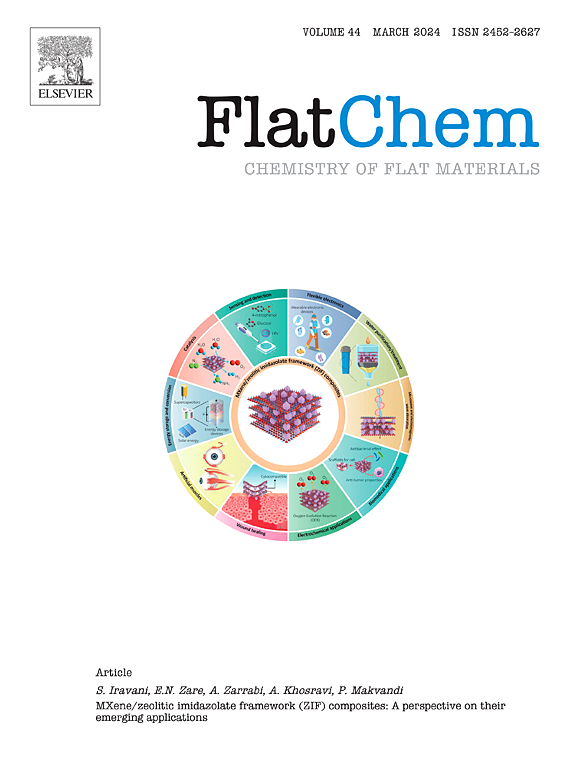对环境应用中基于mxene材料的见解:性能,机制和未来方向
IF 6.2
3区 材料科学
Q2 CHEMISTRY, PHYSICAL
引用次数: 0
摘要
MXenes是二维层状过渡金属碳化物,碳氮化物和氮化物,作为水净化系统的有前途的材料受到了相当大的关注。MXenes独特的层状结构可以提高性能,例如,巨大的表面积和孔隙度,增强的光收集,改进的电荷分离,可调的带隙能量,以及层表面和终端上丰富的官能团(即羟基,氧,氟等)的存在,使其成为完美的吸附剂和光催化剂。然而,由于氢键和范德华力,导致纯MXenes层堆叠,阻碍了原生材料的性能。相反,基于mxene的异质结构可以阻碍层堆叠,并表现出增强的协同效益。本文综述了mxene基复合材料在吸附和光催化方面的研究进展。讨论了MXenes及其复合材料的合成方法,以及各种添加剂和掺杂剂对提高其性能的作用。此外,它还探讨了控制mxene基复合材料的吸附和光催化活性的潜在机制,包括表面缺陷、官能团、能带结构工程和界面电荷转移过程的影响。本文还讨论了基于mxene的复合材料的挑战和前景,以及提高其性能的潜在策略。本文章由计算机程序翻译,如有差异,请以英文原文为准。

Insights into MXene-based materials for environmental applications: Performance, mechanisms, and future directions
MXenes are 2D-layered transition metal carbides, carbonitrides and nitrides that have received considerable attention as promising materials for water purification systems. MXenes' unique layered structure allows for boosted performance, e. g., huge surface area and porosity, enhanced light harvesting, improved charge separation, tunable band gap energies, and the presence of abundant functional groups (i.e., hydroxyl, oxygen, fluorine, etc.) on layers' surfaces and terminals that make them perfect adsorbents and photocatalysts. However, the performance of native materials is hampered owing to hydrogen bonding and Van der Waals force, which cause the layers of pure MXenes to stack. In contrast, MXene-based heterostructures can hinder layer restacking and exhibit enhanced synergistic benefits. This review provides a comprehensive overview of MXene-based composite materials for adsorption and photocatalytic processes. It discusses the synthesis methods of MXenes and their composites, as well as the role of various additives and dopants in enhancing their performance. Furthermore, it explores the underlying mechanisms governing the adsorption and photocatalytic activity of MXene-based composites, including the impact of surface defects, functional groups, band structure engineering, and interfacial charge transfer processes. The review also addresses the challenges and prospects of MXene-based composites, along with potential strategies for improving their performance.
求助全文
通过发布文献求助,成功后即可免费获取论文全文。
去求助
来源期刊

FlatChem
Multiple-
CiteScore
8.40
自引率
6.50%
发文量
104
审稿时长
26 days
期刊介绍:
FlatChem - Chemistry of Flat Materials, a new voice in the community, publishes original and significant, cutting-edge research related to the chemistry of graphene and related 2D & layered materials. The overall aim of the journal is to combine the chemistry and applications of these materials, where the submission of communications, full papers, and concepts should contain chemistry in a materials context, which can be both experimental and/or theoretical. In addition to original research articles, FlatChem also offers reviews, minireviews, highlights and perspectives on the future of this research area with the scientific leaders in fields related to Flat Materials. Topics of interest include, but are not limited to, the following: -Design, synthesis, applications and investigation of graphene, graphene related materials and other 2D & layered materials (for example Silicene, Germanene, Phosphorene, MXenes, Boron nitride, Transition metal dichalcogenides) -Characterization of these materials using all forms of spectroscopy and microscopy techniques -Chemical modification or functionalization and dispersion of these materials, as well as interactions with other materials -Exploring the surface chemistry of these materials for applications in: Sensors or detectors in electrochemical/Lab on a Chip devices, Composite materials, Membranes, Environment technology, Catalysis for energy storage and conversion (for example fuel cells, supercapacitors, batteries, hydrogen storage), Biomedical technology (drug delivery, biosensing, bioimaging)
 求助内容:
求助内容: 应助结果提醒方式:
应助结果提醒方式:


